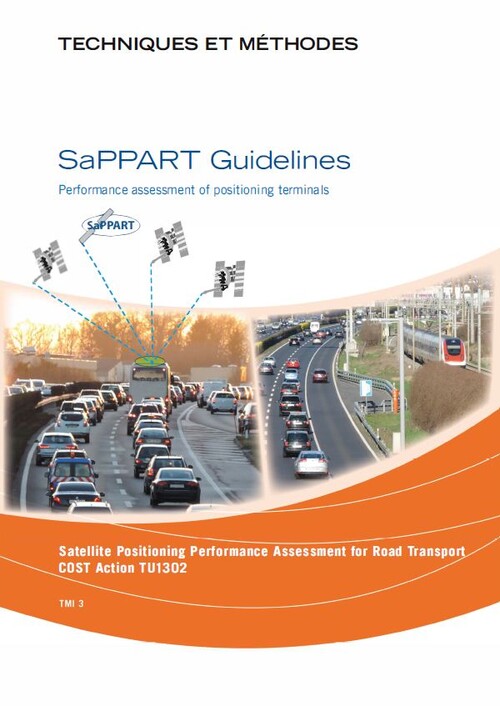SaPPART Guidelines
COST Action TU1302
Guidelines for test procedures for the performance assessment of GNSS-based positioning terminals in ITS applications.

The book in a few words
Effective transportation of people and goods requires an efficient positioning service. This service currently relies mainly on Global Navigation Satellite System (GNSS).
Due to the physical principle of satellite based position determination, the level of performance delivered by any terminal using GNSS highly depends on the conditions it is used in. These influencing conditions are primarily due to the physical features in the built and natural environments around the antenna, which have a strong impact on the propagation of radio-waves. Furthermore, the problem of intentional and unintentional signal interference is a major concern.
Depending on the type of application and positioning requirements, the current GNSS deficiencies can be overcome by hybridization with other positioning sensors and digital spatial data.
In the case of critical applications, the actual performance of the positioning terminal should be determined in terms of availability, accuracy and integrity.
Intelligent transport systems (ITS) stakeholders expressed the need of standardized performance metrics for positioning terminals and the associated performance assessment procedures.These issues have been addressed by the SaPPART COST action, a European network of experts in GNSS, ITS and mobility. Three deliverables have been produced on these topics.
- The white paper introduces the fundamentals of positioning systems, with the focus on GNSS, explaining their role in transportation and stressing the importance of a reliable assessment of their performance.
- The handbook is dedicated to performance issues and the principles for performance assessment of GNSS-based positioning terminals are presented.
- The guidelines provides guidelines for test procedures for the performance assessment of GNSS-based positioning terminals, either by field tests, simulations or their combination
To know more about the book
- François Peyret
- Pierre-Yves Gilliéron
- Uwe Becker, Technische Universität Braunschweig, Germany
- David Bétaille, Institut français des sciences et technologie des transports, de l’aménagement et des réseaux (Ifsttar), France
- Calogero Cristodaro, Politecnico di Torino, Italy
- Fabio Dovis, Politecnico di Torino, Italy
- Jesper Engdahl, Rapp Trans SA, Switzerland
- Pierre-Yves Gilliéron, École polytechnique fédérale de Lausanne (EPFL), Switzerland
- Helena Leppäkoski, Tampere University of Technology, Finland
- Florin Codrut Nemtanu, Politehnica University of Bucharest, Romania
- Mihai Niculescu, Intelligent Transport Systems Romania, Romania
- Miguel Ortiz, Institut français des sciences et technologie des transports, de l’aménagement et des réseaux (Ifsttar), France
- Washington Ochieng, Imperial College, United Kingdom
- François Peyret, Institut français des sciences et technologie des transports, de l’aménagement et des réseaux (Ifsttar), France
- Valérie Renaudin, Institut français des sciences et technologie des transports, de l’aménagement et des réseaux (Ifsttar), France
- Laura Ruotsalainen, Finnish Geospatial Research Institute, National Land Survey (FGI NLS), Finland
- Ioanna Spyropoulou, National Technical University of Athens, Greece
This deliverable, entitled guidelines, is the third outcome of SaPPART COST Action, a European network of scientists and stakeholders that aims to promote smart use of GNSS technology in the field of intelligent road transport and mobility. It discusses the performance assessment of the GNSS-based Positioning terminals (GBPT), which is generally under the responsibility of the system integrators in the road market of GNSS. The aim of this document is to provide guidelines for generic test procedures for the evaluation of GBPT performance, either by field tests, simulations or their combination, compliant with the concepts and the definitions already established in the SaPPART White Paper (TMI 1) and Handbook (TMI 2). The document is intended to provide the reader with a helpful tool for planning the GBPT testing procedures by both discussing the testing in general and by providing some detailed practical information.
- Table of contents
- Executive summary
- Introduction
- Chapter 1. Performance metrics and classes for a positioning terminal
- Chapter 2. Test procedures for GBPT performance assessment
- Conclusion on performance assessment
- References
- Appendix A: R&R tests based on Software Defined Radio
- Appendix B: Some examples of specific functions for R&R tests on hybridized terminals
- List of acronyms
- List of figures
- List of tables
COST Action TU1302. SaPPART Guidelines: Assessment of positioning performance in ITS applications. Ifsttar, 2018. techniques et méthodes, TMI 3. 45p. ISBN 978-2-85782-741-2.
Identity card of the book
| Title: | SaPPART Guidelines: Performance assessment of positioning terminals |
| Author: | COST Action TU1302 |
| Publisher: | IFSTTAR |
| Collection: | The IFSTTAR's collections |
| Reference: | TMI3 |
| ISBN: | 978-2-85782-741-2 |
| Edition: | Pdf file, free download |
| License: | CC BY-NC-ND 4.0 |
| Publication date: | Published in april 2018 |
| Number of pages: | 47 pages |
| Language: | English |
| Key words: | positioning, GNSS, Performance Assessment |
| Contact: | librairie(at)univ-eiffel.fr |




![[Translate to English:] Licence creative commons BY-SA 4.0 [Translate to English:] Licence creative commons BY-SA 4.0](https://reflexscience.univ-gustave-eiffel.fr/fileadmin/ReflexScience/Accueil/Logos/CCbySA.png)